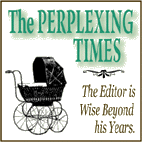
Vol. 1, Issue 28, November 25, 2003







Internet News Unreliable, Say Researchers

In the past three years the World Wide Web has become a primary news source for an increasingly large percentage of the population; all major news outlets now maintain web presences. However, the internet is rife with unreliable information, say researchers at the University of Pennsylvania's Center for the Study of Electronic Media (CSEM).
"We were surprised to find that the accuracy of internationally recognized news sources, such as the Associated Press and Reuters, was not significantly different from that of many websites run by questionable organizations or individuals," said Professor Gerald Quinn at a press conference. "This has significant implications for the continued use of the Web as a source of information."
According to the study, up to 45% of stories listed in online news services such as CNN.com, MSNBC.com, and Reuters were found to draw at least in part on inaccurate information or rumors prevalent on the web. A startling 15% of the total had actually originated as complete fabrications, sometimes even deliberate spoofs of genuine news articles.
At issue is the ease with which misleading or false stories are disseminated through the internet. Stories with compelling headlines can quickly pass through many sources, eventually blurring or masking their provenance, and end up as a news release from a more respectable news outlet.
"In the absence of personal contact, people tend to equate ubiquity with credibility," said Quinn. "If the story is presented from a variety of sources, it is generally seen as genuine, even though it could have a single point of origin."
As part of the five-year study on electronic journalism, researchers planted a series of stories and tracked their progress through the web. The stories ranged from the plausible, such as a change in the federal interest rate, to the patently ludicrous, such as the arrival of UFOs over a major American city.
"There was one UFO story we circulated in 2002 that is still circulating as a genuine event," said Quinn. "It is now attributed to the Associated Press, although the 'AP' version omits some of the original details we put in, such as the bumper stickers visible on the spacecraft."
Other stories planted by the U. Penn researchers and widely disseminated by mainstream media include a hepatitis outbreak in 2001; a cat-cloning experiment at a laboratory in Texas; and a Supreme Court decision arbitrating the results of the 2000 Presidential election.
"We are still paying for that last one," admitted Quinn. "The consequences of that story are more significant than we anticipated, and we regret any inconvenience our naiveté may have caused the nation and/or the world."






